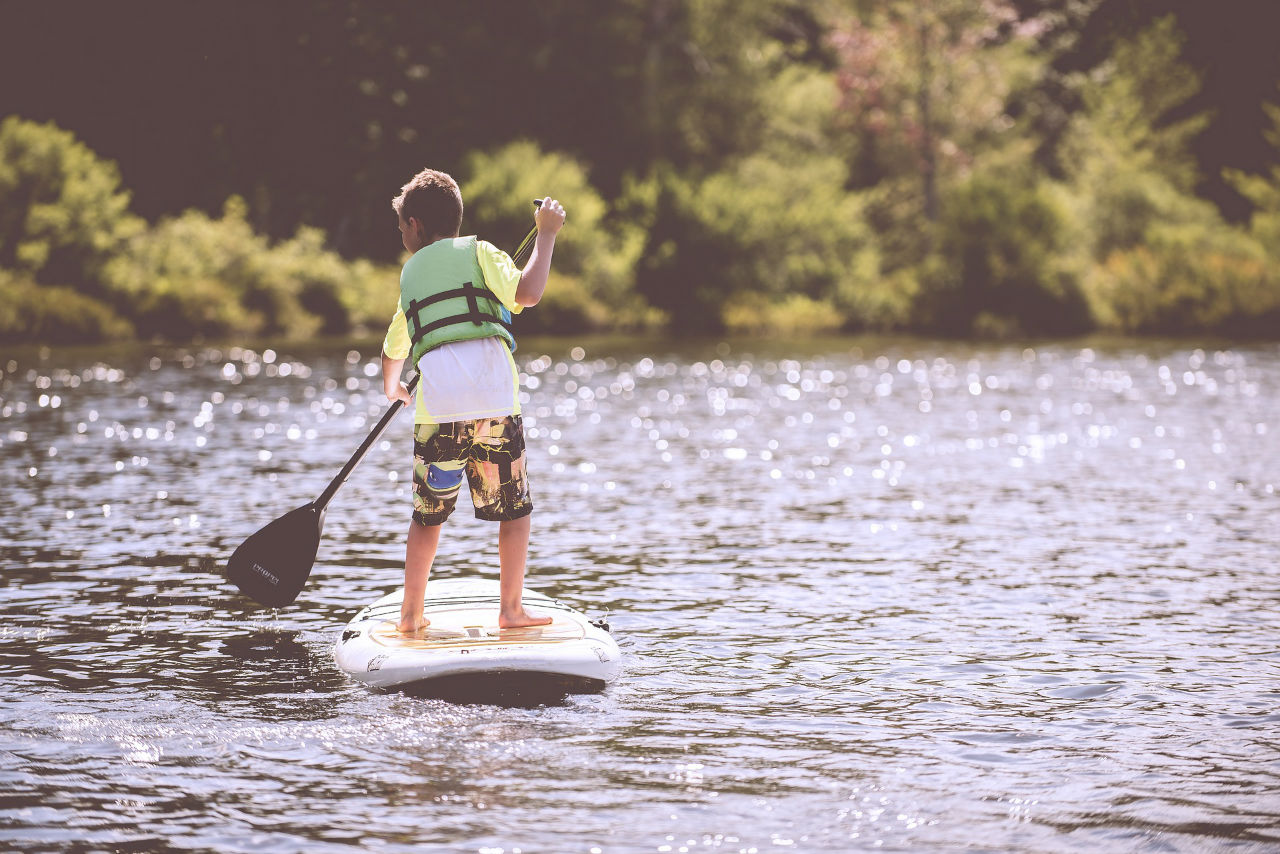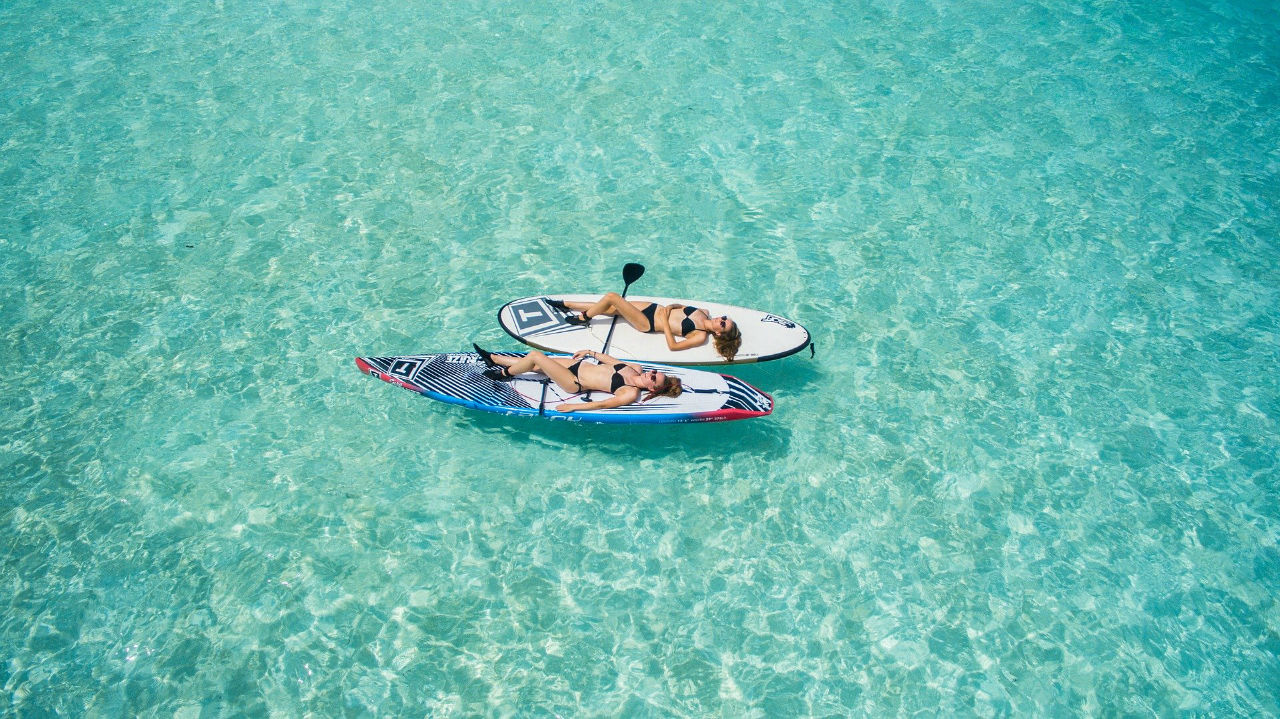Both a sliding sport and a hobby, stand up paddleboarding counts many enthusiasts. But what exactly is it? Who is it for? What equipment does it require? And above all, where can it be practised? Find all the answers below.

What is stand up paddleboarding?
More commonly known as SUP, stand up paddleboarding involves propelling yourself through the water on a board using a paddle. In short, it’s a combination of canoeing and surfing. The sport has its roots in Polynesia and was born at a time when kings crossed lagoons on tree trunks turned into wide planks. The planks made it possible to travel from island to island, for business or otherwise.
The Beach Boys of Oahu in Hawaii adopted SUP in the 1950s. They used it to monitor beaches and swimmers off the coast of Waikiki. By standing up on their boards, they were able to see further and therefore more easily spot any swimmers who needed help — or to be saved.
Other sliding water sports gradually overshadowed SUP for decades. Surfing in particular was a favourite until 2004, when the famous surfer Laird Hamilton organised an SUP competition in Hawaiian waters. He breathed new life into the sport by tackling the most powerful waves.
Since then, SUP has been a strong favourite among waters sports and is becoming increasingly popular worldwide.
What are the prerequisites?
Stand up paddleboarding is suitable for all ages. Certain conditions must be met, however. Children under the age of 12 must be accompanied by an adult. Younger children must sit in the front to ensure greater safety.
If you’re a beginner, your first ventures on a paddle board will be in shallow waters. An instructor will be with you and show you what to do, including the correct posture to adopt and the moves that will help you progress on your own.
If you already have some experience, you can slowly start taking on waves.
What equipment is needed?
Above all, SUP requires a board measuring between 1.5 and 6.5 metres in length. The board can be either rigid or inflatable.
Rigid paddle boards are similar to those used in surfing because the manufacturing technique is basically the same. They are foam boards with a resin layer. They are often the preferred option because they allow for a higher speed. As a matter of fact, rigid boards are used in competitions.
Inflatable paddle boards are appealing on account of their practicality. They are easy to fold away, which makes them more convenient to transport and store. They are mainly used for recreational SUP, particularly excursions. The main drawback is that they’re more fragile. As can be expected, inflatable boards are not immune to punctures. Nevertheless, the most recent models are more durable thanks to the use of technologies that combine functionality and performance.
You will also need an accessory called a leash. One end is attached to the board and the other to your ankle in order to keep you as safe as possible in case you fall.
Lastly, an anti-skid product wouldn’t go amiss, especially if you’re paddleboarding at sea. It’s more commonly known as wax.
Wearing an inflatable vest is recommended.
What are the advantages of stand up paddleboarding?
Paddleboarding is an excellent sporting activity regardless of whether you want to stay in shape or sculpt your body.
The idea is to paddle while standing up and propel yourself through the water. The posture adopted works all your muscles. Your abdominal and back muscles are both heavily involved, as are your arms and legs. SUP actually burns more calories than a core workout.
How fast you progress depends on your balance. What will initially feel like minor constraints will later become healthy habits that will help you correct your posture every day.
What’s more, SUP is usually practised on sunny days. This means that you can fill up on vitamin D and enjoy nature’s fresh air. As such, paddleboarding will also improve your oxygen levels, making the activity more effective for your body.
SUP also reduces stress. Spending time in nature helps you relax despite the physical effort involved. In any case, you can move at your own pace and soak in the peace and quiet around you. Take the time to appreciate the stunning views and discover landscapes that you wouldn’t encounter in the city centre.

Where can you paddleboard?
The best spot will depend on the type of sliding you’re interested in. That’s right — SUP comes in many forms.
Beginners and fans of walking and hiking will undoubtedly prefer calm waters, such as rivers. As long as there are no branches or shallow rocky bottoms, you can use an inflatable paddle. Otherwise, opt for a rigid model.
The surfing version, which is done at sea, involves catching a wave away from the shore and paddling back. This type of paddleboarding can easily be done in Nice, Cannes, Menton, Villefranche and Roquebrune-Cap-Martin. A rigid board offers more power and speed, regardless of whether you’re lying or sitting down or standing up as you rejoin the shore. Please feel free to contact aquareve.org if you would like to try stand up paddleboarding at sea in the Alpes-Maritimes.
In race mode, you need both speed and endurance. When racing, opt for a rigid board, preferably long and thin.
Rivers and streams are perfect for enjoying whitewater SUP. You’ll first need to make an effort to brave indoor waves and improve in waters that are challenging to master. An inflatable board is better suited for rivers because it’s lighter and will more readily absorb the shock of hitting hard surfaces, which you are likely to encounter during your trip down the river.
Although stand up paddleboarding is generally available at water sports centres, it comes in countless forms, including yoga. As long as the water is calm, there is no reason for beginners to feel nervous about their first attempt.
In a nutshell, SUP is a sporting activity that works your muscles and is perfect if you want to build up strength and endurance or sculpt the body of your dreams. Stand up paddleboarding is suitable for all ages as long as you’re properly equipped and listen to the instructors.
